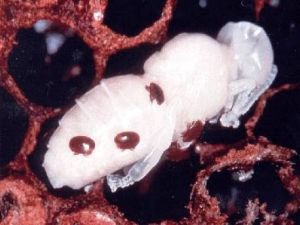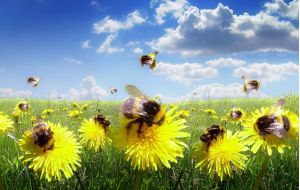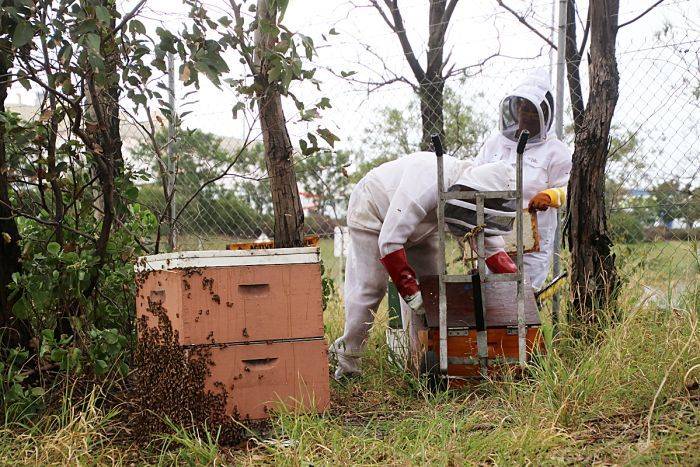VIDEO: Sentinel beehive program provides frontline defence against the varroa mite (ABC News)
Stationed near the major ports of Australia's coastal cities are a group of closely monitored beehives designed to detect the varroa mite parasite that has the potential to decimate bee populations.
Surrounded by thousands of new cars, a coal loading plant, numerous shipping berths and smoke stacks in Port Kembla is a calm area of green space with one of Australia's most important hives.
It is a sentinel hive — a closely monitored colony ready to raise the alarm should a bee carrying the varroa mite arrive in a shipping container and join the swarm.
"It's not if, but when [the mite arrives], and it's going to come in a container of food," bee keeper and sentinel hive custodian John Crouchley said.
"We're the only country in the world that hasn't got the varroa mite problem.
"It's in New Zealand and it's in New Guinea. It's a small mite like a tic that sits on the neck of the bee, sucks its blood and decimates the hive."
More than 65 per cent of horticultural and agricultural crops produced in Australia require honey bees for pollination, meaning the destruction of beehives would be catastrophic for the country's food production.

PHOTO: John and Justine Crouchley inspect sentinel bee hives at Port Kembla. (ABC Illawarra: Justin Huntsdale)
Organisation Bee Aware said for ever year Australia remains free of the varroa mite, industries that rely on honey bee pollination receive a benefit of $50.5 million per year.
"Bees are the absolute epicentre of good things on a cherry orchard because without them, we would be stuffed," Central West New South Wales cherry, apple and grape grower Borry Gartrell said.
The Orange-based farmer contracts a bee keeper to bring in hives each year to pollinate his crops, providing an invaluable service to the livelihood of his farm on Mount Canobolas in Orange.
"It would be a tragedy if varroa mite comes to Australia because the rest of the world are in serious trouble," he said.
"There are lots of areas where they're hand-pollinating crops and [on our farm] we've planted areas that are dependent on something to come in and move pollen from one stage to another."
How the sentinel hives work
Inside each sentinel hive is a pest strip that will kill the varroa mite.

PHOTO: The varroa mite attaches itself to the back of the neck of bees. (Flickr: Randy OHC)
The hive has a mesh bottom board so any mite that is killed will drop onto sticky paper underneath.
"We take those out every six weeks and send them to the DPI and they monitor it," Mr Crouchley said.
"We've been doing it three years and, touch wood, we've had none [varroa mite]."
The National Bee Pest Surveillance Program is an early warning system run by Plant Health Australia, and delivered in New South Wales by the Department of Primary Industries (DPI), and bee keepers like Mr Crouchley and his daughter Justine.
"We may not have that time [to operate the program], so enlisting them as volunteers certainly helps the cause," DPI's NSW Bee Biosecurity Officer Surveillance Mark Page said.
"These people are passionate about keeping bees and in looking after the hives they have the added benefit of collecting honey so it works both ways for everyone."
He said Australia should be proud to have the strongest honeybee biosecurity program in the world, but agrees with Mr Crouchley that the arrival of the varroa mite to Australia is inevitable.
"Varroa tends to take out wild colonies so only managed hives would remain, and it certainly puts an on-cost onto managing hives which would then filter down the chain so pollination events may incur a higher price."
A coastal defender helping out inland farmers

PHOTO: Orange fruit grower Borry Gartrell relies on a contract bee keeper to help pollinate his crops. (ABC Western Plains: Justin Huntsdale)
Nestled into Mount Canobolas on his winery and fruit farm, Mr Gartrell is grateful for the work being done hundreds of kilometres away on the coastline to ensure he and other farmers have healthy bee populations to pollinate their crops.
"It reminds me of the home guard defending the shores of Britain," he said.
"It makes me feel confident the department is on top of this aspect of our production of fruit and vegetables in Australia."
A varroa mite invasion that attacks wild bee populations would significantly increase demand on the beekeepers he pays to provide pollinators for his crops.
"It wouldn't matter what the cost was [of the sentinel beehive program] — even if it was expensive — the cost if we get that mite in will be tens of millions, if not billions of losses if our bees fall on hard times."
ABC Illawarra
By Justin Huntsdale
Posted Fri at 7:10am
http://www.abc.net.au/news/2018-02-23/sentinel-bee-hive-program-defending-against-varroa-mite/9470992





